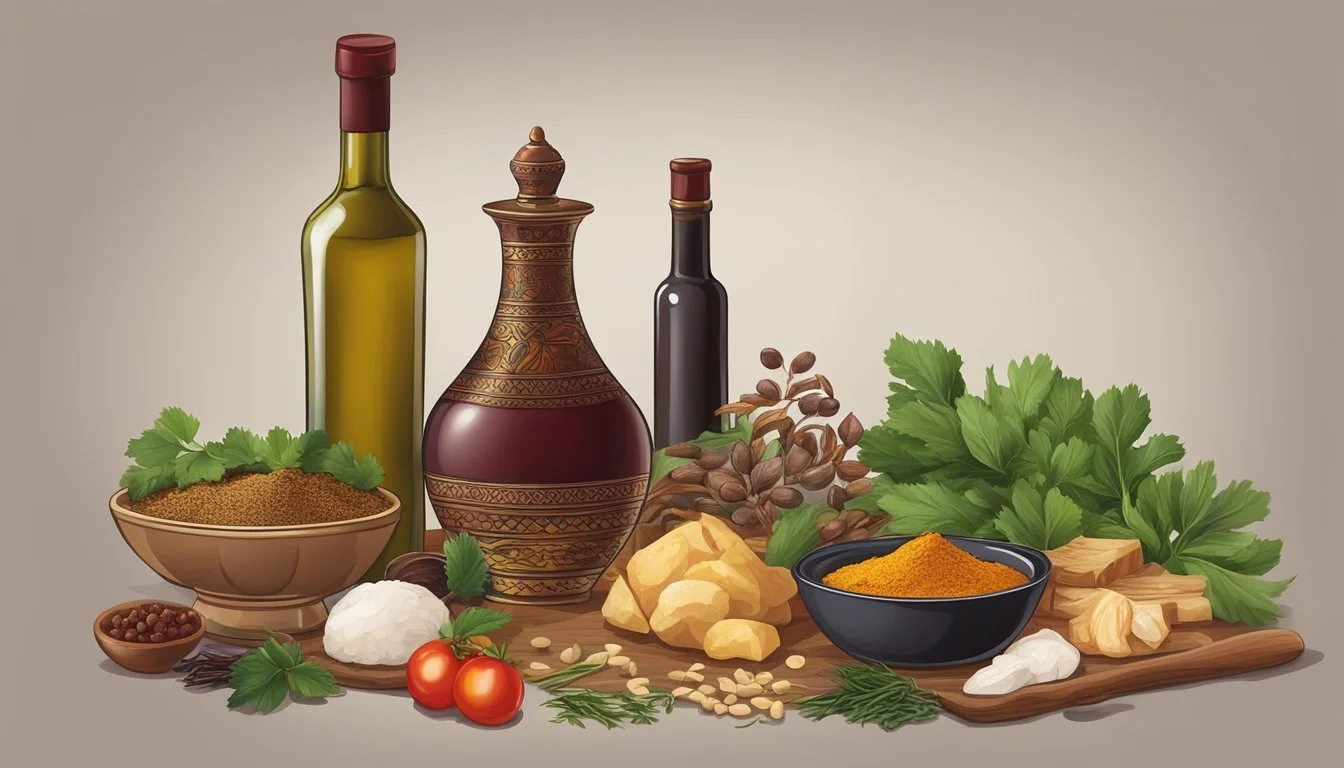What Wine Goes Well with Kazakh Food
Expert Pairing Guide
Kazakhstan's culture is a tapestry of tradition and hospitality, often centered around its cuisine. Traditional Kazakh cuisine is hearty and robust, reflecting the nomadic heritage of the Kazakh people. Rooted in the staples of meat and dairy, typical dishes serve up a rich array of flavors, featuring mutton, beef, and horse meat accompanied by various milk products. The national dish of Kazakhstan, beshbarmak, encapsulates this tradition, with boiled meat served over pasta sheets and topped with a meat broth called shorpo.
Pairing wine with Kazakh food (What wine goes well with Kazakh food?) requires a thoughtful consideration of the rich and often heavy flavors of the dishes. Kazakh meals can vary from the meaty and substantial to the lighter dairy-based beverages like kumis, a fermented mare's milk. The key is to balance the full-bodied dishes with a wine that complements and contrasts the rich flavors without overwhelming the palate.
With the rising interest in both wine consumption and winemaking in Kazakhstan, there's a growing repertoire from which to select pairings. For the robust meat dishes, red wines with a strong body, like those made from the Saperavi grape, indigenous to the region, can enhance the meal's savory elements. In contrast, the fermented tang of kumis might pair better with a crisp white wine such as Aligoté, which is known for its fresh acidity and ability to complement the unique taste of the traditional beverage.
Kazakh Cuisine Overview
Kazakh cuisine is reflective of its Central Asian roots and heavily influenced by the nomadic lifestyle of its people. It centers around meat and dairy products, with horse meat and fermented milk products being distinctive elements.
Influence of Nomadic Lifestyle
The nomadic lifestyle of the Kazakh people has shaped their culinary practices. Historically, they relied on livestock for sustenance, which is why animal products feature prominently in their diet. Mobility necessitated the consumption of food that could be preserved, leading to the prominence of dried meats and fermented milk products.
Common Ingredients in Kazakh Cooking
Key ingredients in Kazakhs' cooking include:
Meat: Primarily horse, lamb, and beef.
Milk Products: Including kumis (fermented mare's milk) and shubat (fermented camel's milk).
Grains such as wheat are used in making homemade pasta for various dishes.
These ingredients form the basis for a cuisine that is rich in proteins and dairy.
Traditional Meals and Dishes
Traditional meals and dishes showcase the rich culinary heritage:
Beshbarmak: Thinly sliced boiled meat, typically horse or lamb, served over sheets of homemade pasta.
Kumis: A traditional drink made from fermented mare's milk.
Sorpa: A hearty broth typically made from lamb, seasoned with salt, pepper, and onion.
Each dish represents a part of the Kazakh culinary identity and is shared across generations in Kazakhstan.
Pairing Wine with Kazakh Food
Kazakh cuisine mirrors the country's nomadic history, with a strong emphasis on meat and dairy. Selecting the right wine can enhance these traditional flavors and textures.
Wine Selection for Meat Dishes
Kazakh meat dishes are hearty and often include beef, lamb, and game, which warrant a wine that can stand up to the robust flavors. For red meats like besbarmak, the national dish, or shashlik, a grilled meat skewer, a full-bodied red wine such as a Syrah or a Cabernet Sauvignon is excellent. These wines carry the tannins and structure to balance the richness of the meat.
Kazy (horse meat sausage): Pair with a bold, tannic red like Malbec
Beshbarmak (boiled meat): A wine with good acidity such as a Zinfandel can cut through the fatty nature of the dish
Matching Wines with Dairy-Based Dishes
Kazakh dairy products like kurt (salty cheese balls) and dishes with sour cream require wines that offer a refreshing counterpoint without overshadowing the subtle flavors. A crisp white wine with mild acidity, such as a Pinot Grigio or a dry Riesling, can complement the creamy textures.
Kurt with Pinot Grigio: The wine's acidity counters the saltiness
Sour cream-based sauces: Riesling's sweetness balances the tang
Choosing Wines for Vegetable-Centric Meals
Though less prominent, vegetables do play a role in Kazakh cuisine. The use of root vegetables and garlic in dishes like sorpa, a nourishing broth, pairs well with light to medium-bodied white wines. A wine with herbaceous qualities like Sauvignon Blanc is a good choice, marrying well with the earthy flavors without overpowering the dish.
Pumpkin or Squash: Enhance with a Chardonnay for a buttery complement
Salads with garlic dressing: Sauvignon Blanc for a refreshing complement
By wisely pairing wines with the key components of Kazakh food, one can elevate their dining experience, taking into account the balance of flavors and textures.
Popular Dishes and Wine Pairings
In Kazakh cuisine, rich flavors from meats and dairy products dominate, presenting excellent opportunities for wine pairings that can either complement or contrast these tastes.
Beshbarmak and Wine Options
Beshbarmak, a traditional Kazakh dish consisting of boiled meat (often horse or mutton), is served atop flat pasta sheets and flavored with a hearty onion sauce. What it demands is a robust red wine that can stand up to the intense meat flavors. A Syrah or Zinfandel with peppery notes can enhance the savory aspect of the onions, while a bold Bordeaux blend will match the richness of the dish.
Pairing Wine with Baursak and Other Snacks
Baursak is a fried bread, typically enjoyed as a snack or with tea in Kazakhstan. These doughy and slightly salty morsels pair well with sparkling wines that cut through the oiliness. A crisp Prosecco or a dry Brut Champagne assists in cleansing the palate. For those who prefer non-sparkling options, a light Chardonnay complements the bread without overwhelming its simple flavors.
Kazakh Desserts and Sweet Wine Selections
Desserts in Kazakhstan often include ingredients like honey, jam, and dried fruit, implying a sweetness level that is well met with sweet wines. A delicate late harvest Riesling, revealing notes of honey, or a lush Muscat will contrast beautifully with a fruit jam-filled dessert. Meanwhile, a fortified Tawny Port, with its nutty undertones, can be a delightful companion to pastry or bread-based sweets that are less intensely sweet.
Cooking Techniques and Food Preparation
Kazakh cuisine employs a variety of cooking methods, with boiling and steaming being predominant for meat dishes, while baking and frying are reserved for flour-based foods. These traditional techniques reflect the pastoral nomadic lifestyle of the Kazakh people.
Boiled and Steamed Cooking Methods
Boiled meat is a staple in Kazakh dishes, with "Beshbarmak" or "Five Fingers" being the most notable. This dish involves boiling horse meat, beef, or mutton until tender and serving it over homemade pasta. The boiling process, which includes seasoning with salt, pepper, and onion, results in a rich broth, known as "shorpo," which accompanies the meat.
Steaming methods are less common but are utilized in dishes such as dumplings, where a dough made from flour, water, eggs, and salt encases fillings of finely chopped meat. These dumplings are then steamed to perfection, maintaining moisture and flavor.
Baking and Frying in Kazakh Cuisine
Baking is essential for creating various breads and pastries in Kazakh cooking, often using a simple mixture of flour, water, eggs, and yeast. Kazakh bakers shape these ingredients into round, flat loaves or intricate designs before baking, leading to a golden crust and soft interior.
Frying is less prominent but still a vital technique for dishes like "baursaks," fluffy pieces of deep-fried dough. The dough, often including yeast, is cut into small pieces and fried until they puff up and turn golden brown. These are served as a side dish or a treat during celebrations.
Historical and Cultural Significance
Kazakh cuisine reflects the rich cultural heritage and the interplay of historical influences from Asian and European regions, making wine pairing a unique venture.
Food in Kazakh Social Traditions
In Kazakhstan, food is much more than sustenance; it serves as a pivotal element in social traditions and celebrations. For the Kazakh people, the dastarkhan—a table lavishly laid with an array of traditional dishes—is a symbol of hospitality and abundance. Social gatherings and festivities are marked by shared meals, where foods like mutton, horse meat, and camel milk are staples.
Kazakh Gastronomy and Identity
Kazakh gastronomy is inseparable from the nation's identity. As the world's largest landlocked country, situated in Central Asia with its borders touching Russia, China, Uzbekistan, and near other countries with Turkic populations like the Uyghurs, Kazakhstan has developed a unique culinary profile. The influence of neighboring cuisines mingled with the indigenous nomadic lifestyle has sculpted a distinctive set of flavors and preferences within Kazakh culture, which includes a preference for full-bodied wines that complement the robust flavors of its food.
Incorporating Kazakh Food in Modern Cuisine
Kazakh cuisine, traditionally hearty and meat-centric, is being innovatively infused into modern culinary practices. Chefs globally are recognizing the rich flavors of Kazakhstan and adapting them for contemporary palates.
Fusion with International Culinary Practices
Kazakh food, with its robust flavors and substantial ingredients, pairs excellently with the boldness of international dishes. Fusion cuisine is an avenue where the simple yet profound tastes of Kazakhstan meet the complexity of global cooking styles. For instance, the traditional Kazakh dish Gente, a millet-based dessert, can be subtly transformed by incorporating international ingredients like coconut milk or cinnamon, presenting a familiar dish with an exotic twist.
International chefs might take the hearty classic Kazakh Kuurdak, typically braised meat and potatoes, and infuse it with flavors like lemongrass or basil to create a new experience that still retains the comforting satisfaction of the original dish. Through such innovative approaches, Kazakh dishes are achieving a harmonious balance with international cuisine, making them more accessible and appealing to a broad audience.
Contemporary Interpretations of Kazakh Dishes
In the contemporary culinary scene, there's a noticeable trend towards simplifying and refining traditional recipes. Kazakh dishes are no exception. The inherently hearty and simple nature of the cuisine lends itself well to modern interpretation.
Chefs focus on highlighting the natural flavors of primary ingredients like horse and camel meat. They often serve these in elegant cuts paired with minimalist garnishes or sauces that enhance rather than overshadow the main component. For example, Zhauzhurek (liver with caul fat) might be presented as a gourmet dish, delicately plated with artistic flourishes.
This contemporary approach reshapes the perception of Kazakh cuisine, presenting it as not only conducive for innovation but also adaptable to the diets of health-conscious consumers. It shows that Kazakh dishes, when reimagined with a modern aesthetic, can stand alongside other esteemed international cuisines with confidence and sophistication.







